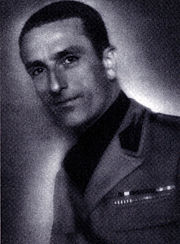
Francesco Giunta
Francesco Giunta (21 March 1887 – 8 June 1971) was an Italian Fascist politician. A leading figure in the early years of fascism, he helped to build the movement in several regions of the country and was particularly active in Trieste. During the Second World War he became notorious for his role in occupied Yugoslavia.
Early fascist career[]
Born in the Tuscan town of San Piero a Sieve, he started his career as a lawyer, having studied law and philosophy at university.[1] He served as a machine gun captain in World War I,[2] having joined the army in 1915.[1] After the war he was involved in the establishment of the ex-service group Associazione Nazionale dei Combattenti, as well as the more overtly political Alleanza di Difesa Cittadina, an anti-socialist group with a strong military bent that was involved in battles with leftists.[1]
An early member of the Italian fascist movement, Giunta was the leader of fascio in Florence before in 1920 being sent the Julian March (Venezia Giulia) to aid Professor Ruggero Conforto in establishing the fascist movement in the region.[1] Having garnered a reputation as a good organiser, he was subsequently sent to Trieste that same year to work under Gabriele D'Annunzio.[3] Under the direction of D'Annunzio he became the propaganda chief in Fiume[4] and a deputy for the city from 1921 to 1939.[1] He worked with Benito Mussolini to set up a number of Fascist squads that attacked a group of allegedly separatist Slovenes in northern Istria.[4] As a Fascist leader (ras) of Trieste, he built up an early mass support base for the Fascist movement.[5] In July 1920, he led the squad that burnt down the Narodni dom, the community centre of the Slovenes in Trieste.[6] Giunta gained fame in March 1922 when he followed the example of D'Annunzio by staging a coup in the Free State of Fiume with 2000 followers and by doing so laying down the foundations for the official Italian takeover in 1924.[7]
In October 1922, he commanded the Fascists from the Julian March on the March on Rome.[citation needed] His leading position in the early years of fascism came despite his Freemasonry, a movement to which Mussolini was bitterly opposed.[8]
Under Mussolini's government[]
He became national secretary of the National Fascist Party in succession to Michele Bianchi in 1923 and oversaw the move towards an increasingly diminished role for the party rank and file as Mussolini consolidated his government.[9] He also sought to increase party discipline and was behind a brutal physical attack on Cesare Forni, a leading dissident within the Fascist movement.[10]
Replaced by Roberto Farinacci the following year, Giunta settled into an undersecretary's role in the cabinet office.[11] In this role he was pivotal in signalling one of the future intentions of Italian foreign policy when he stated in an April 1933 visit to Malta that he was on Italian soil and that the future of the island lay in complete union with Italy.[12] He also acted as vice-president of the Chamber of Deputies from 1924 and in this role was declared immune from prosecution in March 1925 when magistrates in Milan attempted to charge him over the attack on Forni.[10]
Dalmatia[]
In February 1943, he succeeded Giuseppe Bastianini as the Governor of Dalmatia. A fervent anti-Yugoslav since the times of his activity in the South Slav-inhabited Julian March, Giunta brought a number of his old colleagues from Trieste with himself.[citation needed] His regime became noted for its brutality against the local Croat population, and a fierce repression of the Yugoslav partisan movement present in the area.[13]
He was subsequently involved in the Italian Social Republic, although on a personal level he was largely unenthusiastic about the regime.[10]
Post-war activity[]
After World War II, Yugoslavia demanded the extradition of Giunta, so that he could be tried for war crimes committed in Yugoslavia.[citation needed] The Yugoslav demand was rejected by both Italy and the Allies.[citation needed]
He was involved in the 1947 Dumini trial, which investigated the murder of Giacomo Matteotti. He was not charged in relation to this but indicted on further, unrelated charges, the same year.[10] Giunta settled in Rome, where he died in 1971.[10]
References[]
- ↑ 1.0 1.1 1.2 1.3 1.4 Philip Rees, Biographical Dictionary of the Extreme Right Since 1890, Harvester Wheatsheaf, 1990, p. 150
- ↑ Alan Kramer, Dynamic of destruction, 2007, p. 302
- ↑ Paul H. Lewis, Latin Fascist Elites, 2002, p. 17
- ↑ 4.0 4.1 C.P. Blamires, World Fascism - A Historical Encyclopedia, ABC-CLIO, 2006, p. 239
- ↑ S.J. Woolf, Fascism in Europe, 1981, p. 48
- ↑ DOMOV - Fašisti so v Trstu zažgali Slovenski narodni dom
- ↑ Paul H. Lewis, Latin Fascist Elites, 2002, p. 31
- ↑ Nicholas Farrell, Mussolini: A New Life, p. 134
- ↑ Adrian Lyttelton, The Seizure of Power, 2004, p. 183
- ↑ 10.0 10.1 10.2 10.3 10.4 Rees, Biographical Dictionary of the Extreme Right Since 1890, p. 151
- ↑ Maria Wyke, Julius Caesar in Western Culture, 2006, p. 257
- ↑ Manfred Pfister & Ralf Hertel, Performing National Identity , 2008, pp. 173-4
- ↑ Jozo Tomasevich, War and revolution in Yugoslavia, 1941-1945, 2001, pp. 136-7
The original article can be found at Francesco Giunta and the edit history here.